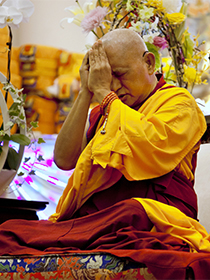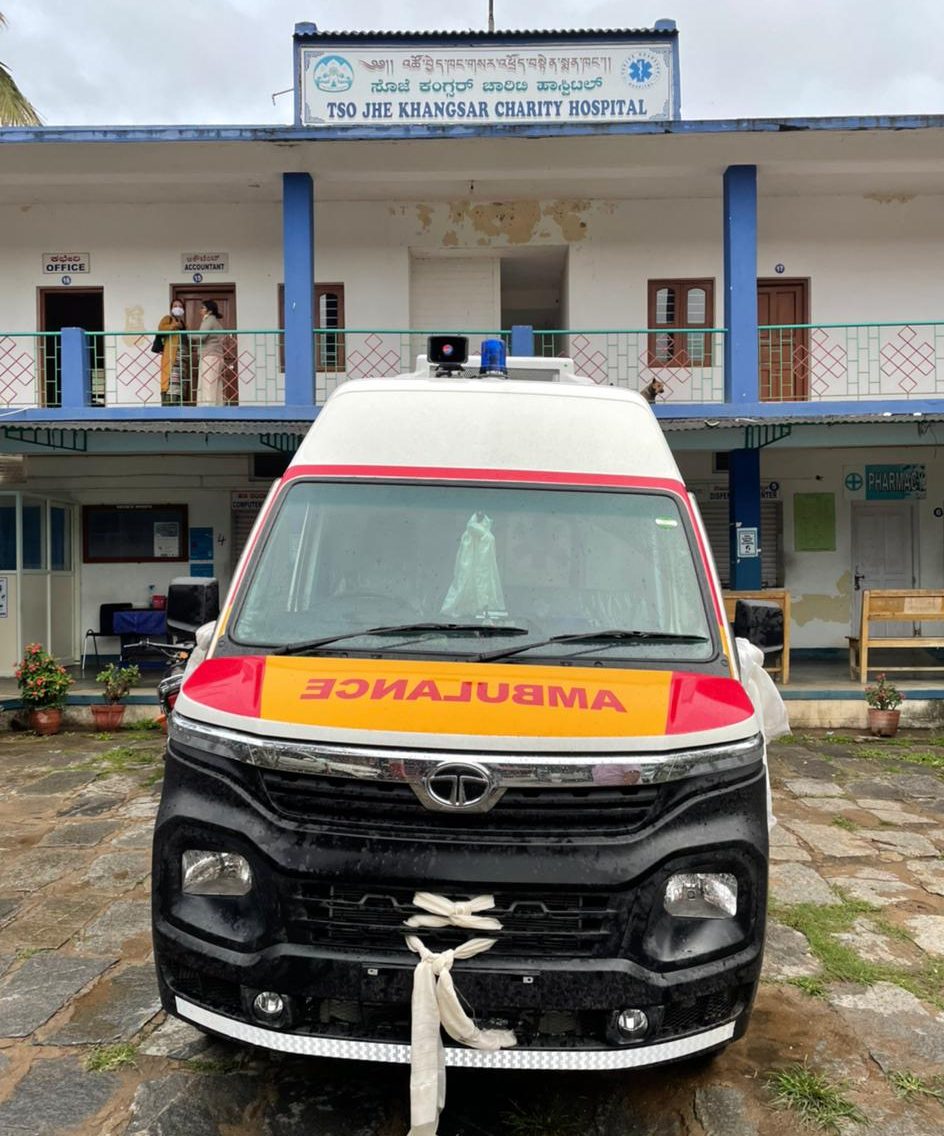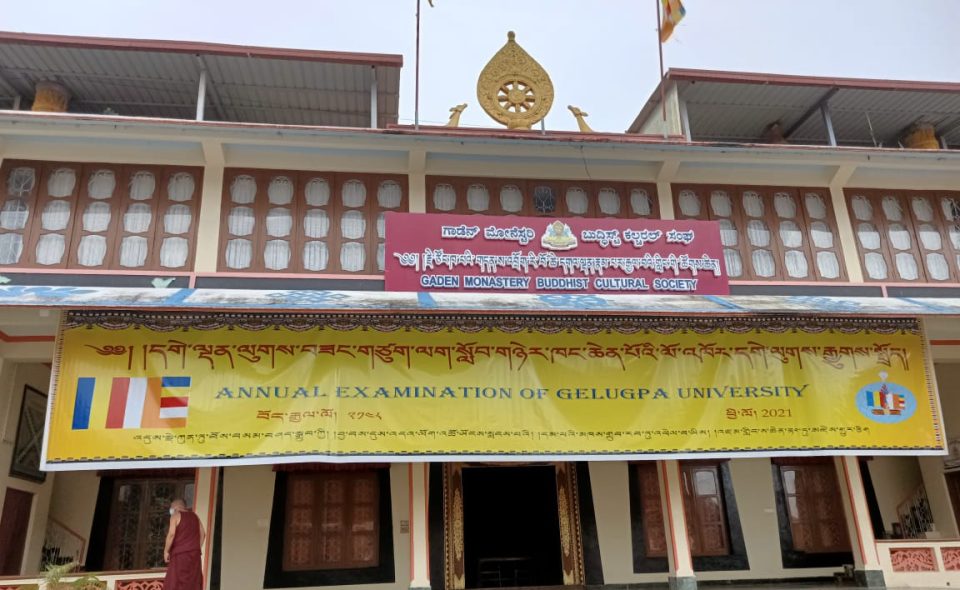- Home
- FPMT Homepage
Foundation for the Preservation of the Mahayana Tradition
The FPMT is an organization devoted to preserving and spreading Mahayana Buddhism worldwide by creating opportunities to listen, reflect, meditate, practice and actualize the unmistaken teachings of the Buddha and based on that experience spreading the Dharma to sentient beings. We provide integrated education through which people’s minds and hearts can be transformed into their highest potential for the benefit of others, inspired by an attitude of universal responsibility and service. We are committed to creating harmonious environments and helping all beings develop their full potential of infinite wisdom and compassion. Our organization is based on the Buddhist tradition of Lama Tsongkhapa of Tibet as taught to us by our founders Lama Thubten Yeshe and Lama Thubten Zopa Rinpoche.
- Willkommen
Die Stiftung zur Erhaltung der Mahayana Tradition (FPMT) ist eine Organisation, die sich weltweit für die Erhaltung und Verbreitung des Mahayana-Buddhismus einsetzt, indem sie Möglichkeiten schafft, den makellosen Lehren des Buddha zuzuhören, über sie zur reflektieren und zu meditieren und auf der Grundlage dieser Erfahrung das Dharma unter den Lebewesen zu verbreiten.
Wir bieten integrierte Schulungswege an, durch denen der Geist und das Herz der Menschen in ihr höchstes Potential verwandelt werden zum Wohl der anderen – inspiriert durch eine Haltung der universellen Verantwortung und dem Wunsch zu dienen. Wir haben uns verpflichtet, harmonische Umgebungen zu schaffen und allen Wesen zu helfen, ihr volles Potenzial unendlicher Weisheit und grenzenlosen Mitgefühls zu verwirklichen.
Unsere Organisation basiert auf der buddhistischen Tradition von Lama Tsongkhapa von Tibet, so wie sie uns von unseren Gründern Lama Thubten Yeshe und Lama Thubten Zopa Rinpoche gelehrt wird.
- Bienvenidos
La Fundación para la preservación de la tradición Mahayana (FPMT) es una organización que se dedica a preservar y difundir el budismo Mahayana en todo el mundo, creando oportunidades para escuchar, reflexionar, meditar, practicar y actualizar las enseñanzas inconfundibles de Buda y en base a esa experiencia difundir el Dharma a los seres.
Proporcionamos una educación integrada a través de la cual las mentes y los corazones de las personas se pueden transformar en su mayor potencial para el beneficio de los demás, inspirados por una actitud de responsabilidad y servicio universales. Estamos comprometidos a crear ambientes armoniosos y ayudar a todos los seres a desarrollar todo su potencial de infinita sabiduría y compasión.
Nuestra organización se basa en la tradición budista de Lama Tsongkhapa del Tíbet como nos lo enseñaron nuestros fundadores Lama Thubten Yeshe y Lama Zopa Rinpoche.
A continuación puede ver una lista de los centros y sus páginas web en su lengua preferida.
- Bienvenue
L’organisation de la FPMT a pour vocation la préservation et la diffusion du bouddhisme du mahayana dans le monde entier. Elle offre l’opportunité d’écouter, de réfléchir, de méditer, de pratiquer et de réaliser les enseignements excellents du Bouddha, pour ensuite transmettre le Dharma à tous les êtres. Nous proposons une formation intégrée grâce à laquelle le cœur et l’esprit de chacun peuvent accomplir leur potentiel le plus élevé pour le bien d’autrui, inspirés par le sens du service et une responsabilité universelle. Nous nous engageons à créer un environnement harmonieux et à aider tous les êtres à épanouir leur potentiel illimité de compassion et de sagesse. Notre organisation s’appuie sur la tradition guéloukpa de Lama Tsongkhapa du Tibet, telle qu’elle a été enseignée par nos fondateurs Lama Thoubtèn Yéshé et Lama Zopa Rinpoché.
Visitez le site de notre Editions Mahayana pour les traductions, conseils et nouvelles du Bureau international en français.
Voici une liste de centres et de leurs sites dans votre langue préférée
- Benvenuto
L’FPMT è un organizzazione il cui scopo è preservare e diffondere il Buddhismo Mahayana nel mondo, creando occasioni di ascolto, riflessione, meditazione e pratica dei perfetti insegnamenti del Buddha, al fine di attualizzare e diffondere il Dharma fra tutti gli esseri senzienti.
Offriamo un’educazione integrata, che può trasformare la mente e i cuori delle persone nel loro massimo potenziale, per il beneficio di tutti gli esseri, ispirati da un’attitudine di responsabilità universale e di servizio.
Il nostro obiettivo è quello di creare contesti armoniosi e aiutare tutti gli esseri a sviluppare in modo completo le proprie potenzialità di infinita saggezza e compassione.
La nostra organizzazione si basa sulla tradizione buddhista di Lama Tsongkhapa del Tibet, così come ci è stata insegnata dai nostri fondatori Lama Thubten Yeshe e Lama Zopa Rinpoche.
Di seguito potete trovare un elenco dei centri e dei loro siti nella lingua da voi prescelta.
- 欢迎 / 歡迎
简体中文
“护持大乘法脉基金会”( 英文简称:FPMT。全名:Foundation for the Preservation of the Mahayana Tradition) 是一个致力于护持和弘扬大乘佛法的国际佛教组织。我们提供听闻,思维,禅修,修行和实证佛陀无误教法的机会,以便让一切众生都能够享受佛法的指引和滋润。
我们全力创造和谐融洽的环境, 为人们提供解行并重的完整佛法教育,以便启发内在的环宇悲心及责任心,并开发内心所蕴藏的巨大潜能 — 无限的智慧与悲心 — 以便利益和服务一切有情。
FPMT的创办人是图腾耶喜喇嘛和喇嘛梭巴仁波切。我们所修习的是由两位上师所教导的,西藏喀巴大师的佛法传承。
繁體中文
護持大乘法脈基金會”( 英文簡稱:FPMT。全名:Found
ation for the Preservation of the Mahayana Tradition ) 是一個致力於護持和弘揚大乘佛法的國際佛教組織。我們提供聽聞, 思維,禪修,修行和實證佛陀無誤教法的機會,以便讓一切眾生都能 夠享受佛法的指引和滋潤。 我們全力創造和諧融洽的環境,
為人們提供解行並重的完整佛法教育,以便啟發內在的環宇悲心及責 任心,並開發內心所蘊藏的巨大潛能 — 無限的智慧與悲心 – – 以便利益和服務一切有情。 FPMT的創辦人是圖騰耶喜喇嘛和喇嘛梭巴仁波切。
我們所修習的是由兩位上師所教導的,西藏喀巴大師的佛法傳承。 察看道场信息:
- FPMT Homepage
- News/Media
-
- Study & Practice
-
-
- About FPMT Education Services
- Latest News
- Programs
- New to Buddhism?
- Buddhist Mind Science: Activating Your Potential
- Heart Advice for Death and Dying
- Discovering Buddhism
- Living in the Path
- Exploring Buddhism
- FPMT Basic Program
- FPMT Masters Program
- FPMT In-Depth Meditation Training
- Maitripa College
- Lotsawa Rinchen Zangpo Translator Program
- Universal Education for Compassion & Wisdom
- Online Learning Center
-
- Prayers & Practice Materials
- Overview of Prayers & Practices
- Full Catalogue of Prayers & Practice Materials
- Explore Popular Topics
- Benefiting Animals
- Chenrezig Resources
- Death & Dying Resources
- Lama Chopa (Guru Puja)
- Lama Zopa Rinpoche: Compendium of Precious Instructions
- Lama Zopa Rinpoche: Life Practice Advice
- Lama Zopa Rinpoche Practice Series
- Lamrim Resources
- Mantras
- Prayer Book Updates
- Purification Practices
- Sutras
- Thought Transformation (Lojong)
- Audio Materials
- Dharma Dates - Tibetan Calendar
- Translation Services
- Publishing Services
- Ways to Offer Support
- Prayers & Practice Materials
-
- Teachings and Advice
- Find Teachings and Advice
- Lama Zopa Rinpoche Advice Page
- Lama Zopa Rinpoche: Compendium of Precious Instructions
- Lama Zopa Rinpoche Video Teachings
- ༧སྐྱབས་རྗེ་བཟོད་པ་རིན་པོ་ཆེ་མཆོག་ནས་སྩལ་བའི་བཀའ་སློབ་བརྙན་འཕྲིན།
- Podcasts
- Lama Yeshe Wisdom Archive
- Buddhism FAQ
- Dharma for Young People
- Resources on Holy Objects
- Teachings and Advice
-
-
*If a menu item has a submenu clicking once will expand the menu clicking twice will open the page.
-
-
- Centers
-
- Teachers
-
- Projects
-
-
-
-
*If a menu item has a submenu clicking once will expand the menu clicking twice will open the page.
-
-
- FPMT
-
-
-
-
-
The whole thing, so many practices, all come down to live the daily life with bodhicitta motivation to put all the effort in that whatever you do. This way your life doesn’t get wasted and it becomes full of joy and happiness, with no regrets later, especially when you die and you can die with a smile outside and a smile in the heart.
Lama Zopa Rinpoche
-
-
-
- Shop
-
-
-
The Foundation Store is FPMT’s online shop and features a vast selection of Buddhist study and practice materials written or recommended by our lineage gurus. These items include homestudy programs, prayers and practices in PDF or eBook format, materials for children, and other resources to support practitioners.
Items displayed in the shop are made available for Dharma practice and educational purposes, and never for the purpose of profiting from their sale. Please read FPMT Foundation Store Policy Regarding Dharma Items for more information.
-
-
Projects
4
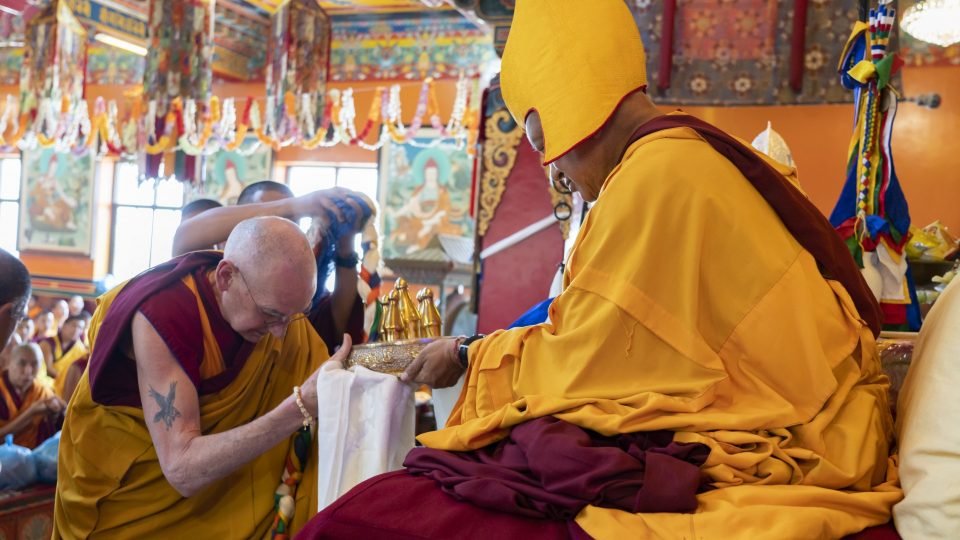
Ven. Roger Kunsang offering a mandala to Lama Zopa Rinpoche during the April 19, 2021 long life puja at Kopan Monastery
Every year Ven. Roger Kunsang, on behalf of the FPMT organization, checks with Lama Zopa Rinpoche’s gurus and/or Rangjung Neljorma Khadro Namsel Drönme (Khadro-la), to determine what practices should be done to help create the conditions for Lama Zopa Rinpoche to have a long life and good health for the coming year.
The first offering to Rinpoche arranged this year will be a White Tara long life puja on March 11, 2022, at Kopan Monastery. This special long life puja will involve seven days of preparation led by Khadro-la with the Kopan monks. At a later date there will be a Most Secret Hayagriva tsog kong and a Guru Rinpoche bum tsog also offered according to the advice received.

Khadro-la making an offering during a long life puja to Lama Zopa Rinpoche, April 2021. Photo by Ven. Lobsang Sherab.
Our prayers have tremendous power and we invite you to join us by rejoicing in the puja being offered, generating your own prayers for Rinpoche’s health and long life, or making an offering toward the expenses associated with the pujas and practices for Rinpoche’s health and long life.
For additional recent advice from Khadro-la on mantra recitations to do for Lama Zopa Rinpoche, His Holiness the Dalai Lama, and the entire FPMT organization see: fpmt.org/lama-zopa-rinpoche-news-and-advice/mantra-recitations-for-his-holiness-the-dalai-lama-lama-zopa-rinpoche-and-fpmt
Lama Zopa Rinpoche is the spiritual director of the Foundation for the Preservation of Mahayana Tradition (FPMT), a Tibetan Buddhist organization dedicated to the transmission of the Mahayana Buddhist tradition and values worldwide through teaching, meditation and community service.
The Long Life Puja Fund always contributes to long life pujas offered to Lama Zopa Rinpoche. You can also learn about the many Charitable Projects of FPMT and discover how the various funds and projects are benefiting others.
28
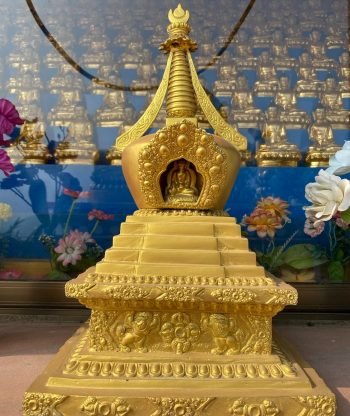
One of the stupas which are part of the 1,000 Buddha altar at Kopan Monastery.
Holy objects are so powerful one can purify negativities and create merit just by seeing them. According to the Sutra of the Mudra of Developing the Power of Devotion, “The minute you see a holy object you create infinite merits, so no question, if you actually make prostrations, offerings and so forth, you create far greater merit.”
The Holy Objects Fund provides the resources to create holy objects around the world for the success of the FPMT organization and to benefit of all beings.
We are so happy to share with you of some new holy objects that have come into being recently.
Large Dzambala and Ganapati statues
Two new statues have been sponsored and will be at Kopan Monastery. These statues are specifically for the success and abundance of the whole FPMT organization. Special offerings will be made daily to each and regular practices will be done in front of them as advised by Lama Zopa Rinpoche. These statues were jointly offered by FPMT International Office and Lama Zopa Rinpoche.
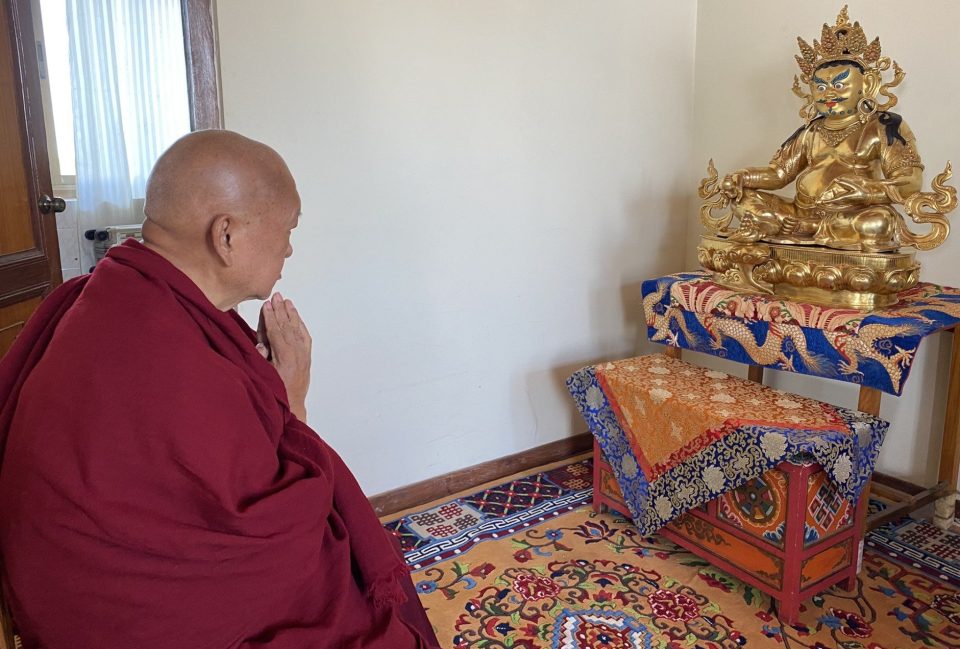
Lama Zopa Rinpoche greeting the new Dzambala statue on arrival to Kopan Monastery.
Lama Zopa Rinpoche manifested joy when the 3.5 ft Dzambala statue arrived at Kopan, personally welcoming the statue with prostrations, five-colored khata offering, mandala offering, and tsog, Rinpoche had written a special requesting letter to Dzambala with prayers and requests for the organization and all beings, and Rinpoche offered this letter of requests to Dzambala. Please enjoy this very precious video of Dzambala’s arrival to Kopan:
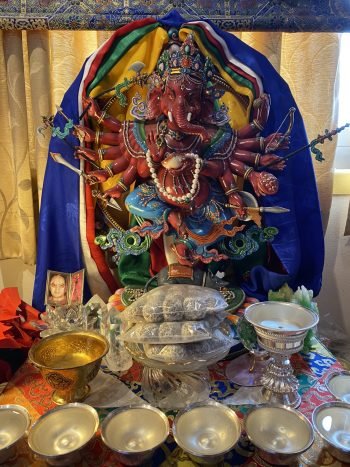
The new Ganapati statue at Kopan Monastery will be based on this statue.
Rinpoche has also advised for a Ganapati statue, which is in the process of being built. It will be 7 ft tall and based on the details of this smaller Ganapati statue (to the right) at Kopan Monastery.
Prayer Wheel in Thame, Nepal
The Mount Everest region of Thame, Nepal, is a special place for FPMT. Lama Zopa Rinpoche was born there and it is located near Lawudo which was the home of Rinpoche’s previous incarnation.
A new 9 ft x 6 ft prayer wheel is being built outside of the house where Rinpoche was born. Rinpoche explains, “My sister Ani-la Ngawang Samten, the key person at Lawudo Gompa, initiated the project to build this prayer wheel near the house where I was born. She herself offered several 100,000 rupees toward the building of the prayer wheel as she wanted very much to see it actualized. I became involved because she alone could not afford to sponsor this prayer wheel containing 100 trillion mantras on microfilm (using nanotechnology) and more than 1.5 billion mantras on paper, along with the building needed to house it.”
Rinpoche wrote an extensive dedication prayer for this project, dedicating the merit of sponsoring and commissioning the building of the prayer wheel to the Guru, Buddha, Dharma, Sangha, for all the benefactors and generous people, for all evil beings (those who cause harm), for all the sentient beings of the six realms and intermediate state, and also dedicating the merit to stop the dangers caused by the four elements.
Rinpoche mentions: “I dedicate all the merits of building and sponsoring this prayer wheel to everyone who comes here to see it and to everyone who turns it. I dedicate all the merits of building and sponsoring the prayer wheel to all the sentient beings who rely on me, all those for whom I have promised to pray, and all those whose names have been given to me, both the living and the dead. May they all achieve the peerless happiness of enlightenment as quickly as possible. I dedicate all the merits of having built this prayer wheel for everyone in this world to achieve temporal and ultimate happiness.”
Eight Aspects of Stupas
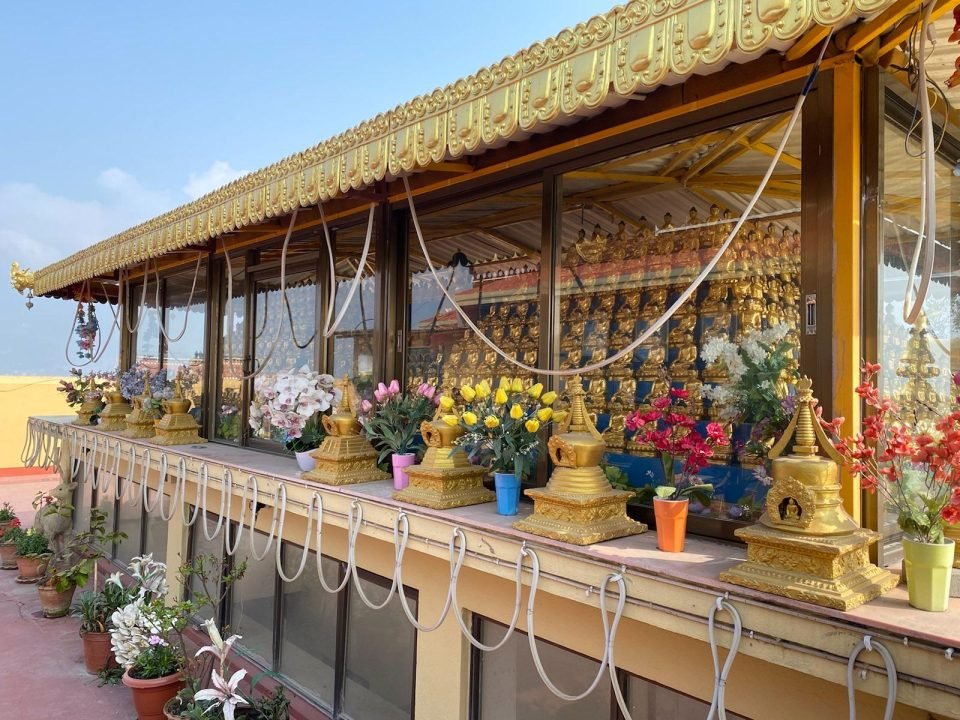
1,000 Buddha altar at Kopan Monastery. Eight more stupas will join the holy objects which are already there to help Ven. Roger create as much merit as possible while circumambulating on the phone.
Eight new stupas are being added to the 1,000 Buddha altar outside of Rinpoche’s room at Kopan. Rinpoche wanted to add an extra eight stupas to this extensive altar “for Venerable Roger Kunsang’s quick enlightenment, as Roger spends so much time on the phone doing business, while walking around the 1,000 Buddha altar, so to add eight more stupas will allow him to have more holy objects to circumambulate.” These eight different aspects of stupas are in the process of being made and will be placed at either end of the 1,000 Buddha altar.
Rinpoche previously offered advice on how to make talking on the phone beneficial by circumambulating holy objects while doing so.
Tremendous thanks to Kopan for helping to actualize all these new holy objects.
Tara Statue for a Retreat House
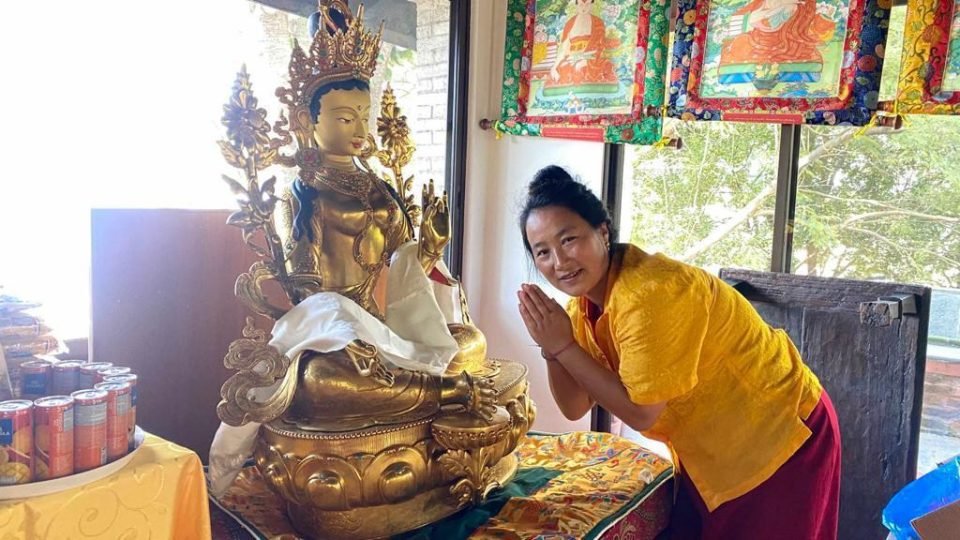
Khadro-la with the Tara statue recently offered to her by Lama Zopa Rinpoche.
During Lama Zopa Rinpoche’s seventy-sixth birthday at Kopan Monastery, a large Green Tara statue was offered to Rinpoche during the Sixteen Arhats long life puja by a number of students and FPMT International Office. Rinpoche proceeded to offer this beautiful statue to Rangjung Neljorma Khadro Namsel Drönme (Khadro-la) for her retreat place.
The Benefits of Holy Objects
Holy objects provide easy opportunities for one to purify negative seeds in the mind and to accumulate merit needed on the path to enlightenment. Further, they provide inspiration as they represent the limitless potential (and perfection) of our own body, speech, and mind. They remind us that liberation is possible, they habituate our mind toward happiness rather than suffering, and they help to preserve the Buddhist culture of which we’re a part.
Lama Zopa Rinpoche has explained, “Every time you look at holy objects – pictures of the Buddha, statues, scriptures, stupas – they plant the seed of liberation and enlightenment in your mental continuum. So every time you look at them they purify your mind. How? When you look at them they plant a seed or positive imprint on your mental continuum so that later when you meet Buddhadharma, either in this life or in future lives, you are able to understand the words and the meaning of the teachings. From that, you are able to practice the meaning of the Dharma you have understood, which causes you to cease the gross and subtle defilements by actualizing the path and then your mental continuum becomes omniscient mind. This is what is meant when we say that by seeing holy objects it plants the seed of enlightenment on the mind – it contains the whole path from guru devotion and the three principles up to the two stages of tantra and enlightenment.”
All are welcome to contribute to the creation of holy objects and support Lama Zopa Rinpoche’s wishes. Rinpoche has expressed, “My wish is for FPMT to build many holy objects everywhere, as many as possible. Making it so easy for sentient beings to purify their heavy negative karma and making it so easy for sentient beings to create extensive merit. Which makes it so easy to achieve the realizations of the path and so easy to achieve liberation and enlightenment.”
To help ensure grants like this continue toward holy objects, we invite you to offer a donation of any amount to the Holy Objects Fund.
- Tagged: holy object fund, holy objects, prayer wheels, statues, stupas
7
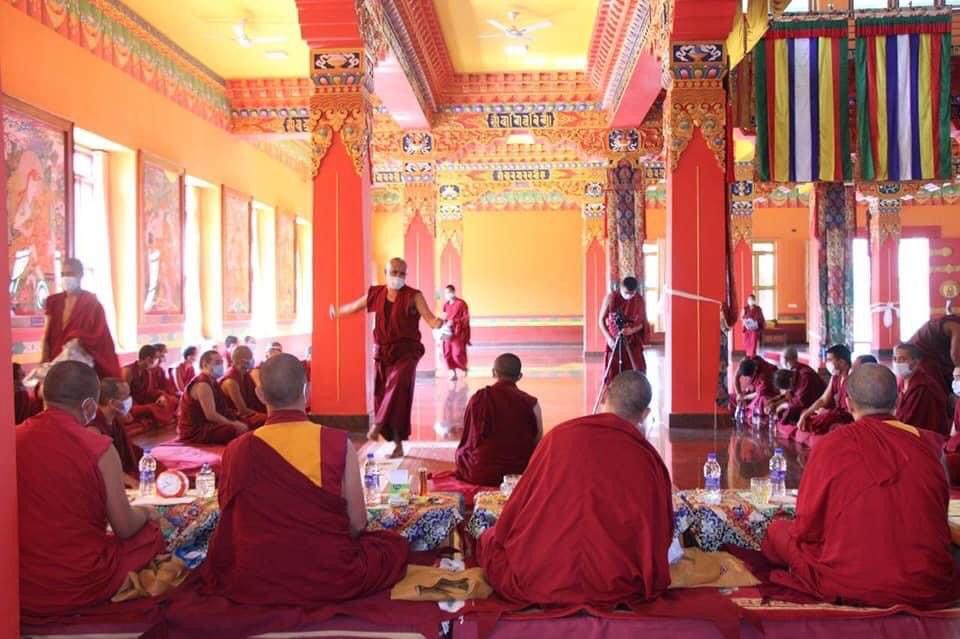
Monks of Tashi Lhunpo Monastery engaged in debate.
Tashi Lhunpo Monastery, located in Bylakuppe, Southern India, and seat to the Panchen Lama, has grown significantly over the last few decades and is now home to 415 monks and one of the major centers of Tibetan Buddhist study and practice in exile in India.
Tashi Lhunpo Monastery was founded by His Holiness the 1st Dalai Lama, Gyalwa Gedun Drupa in 1447, and became the most vibrant monastery in U-Tsang province of Tibet. Over the years, the monastery flourished as a center of learning, and played a vital role in the preservation of Mahayana Buddhist Philosophy and practice. By 1959, this monastery was responsible for the education of 7,000 monks from within and outside of Tibet. Following the Chinese invasion of Tibet, the monastery was not able to continue in its previous form. In 1972, under the guidance of His Holiness the Dalai Lama and with determination of the senior monks, the monastery was re-established in Bylakuppe, Karnataka State.
The monastery is comprised of Tashi Lhunpo Monastic School for young monks, Higher Buddhist Studies which takes twenty-four years to complete, and Tashi Lhunpo Tantric College to complete the lifetime study curriculum and program.
As the monastery continues to grow, additions are needed to support the conditions needed to ensure quality education. A courtyard was added in 2012, a new prayer hall was completed in 2015, an expansive library was added in 2016, and now we are so happy to offer a grant for a new 27,000 square foot debate courtyard being built with permanent canopies over it. This courtyard was needed for several reasons. Primarily, during monsoon season the monks have limited space to debate due to the months of heavy rain. Additionally, the heat can become intolerable without shade and when the monks are cramped into limited indoor space, the echo of their voices disturbs the quality of sound and understanding each other properly during debate becomes difficult. An additional benefit of this extension will be that the monastery can utilize this space for ceremonies, functions, and for grand debate sessions with additional monasteries (Upper Chotok Chemo). In short, this new courtyard will enable the monks to debate uninterrupted through the year without any external hindrances and space limitations.
Lama Zopa Rinpoche wanted very much to support the monastery with this project and through the Supporting Ordained Sangha Fund, US$430,575 was granted for this debate courtyard which will benefit the monks studying there for generations to come.
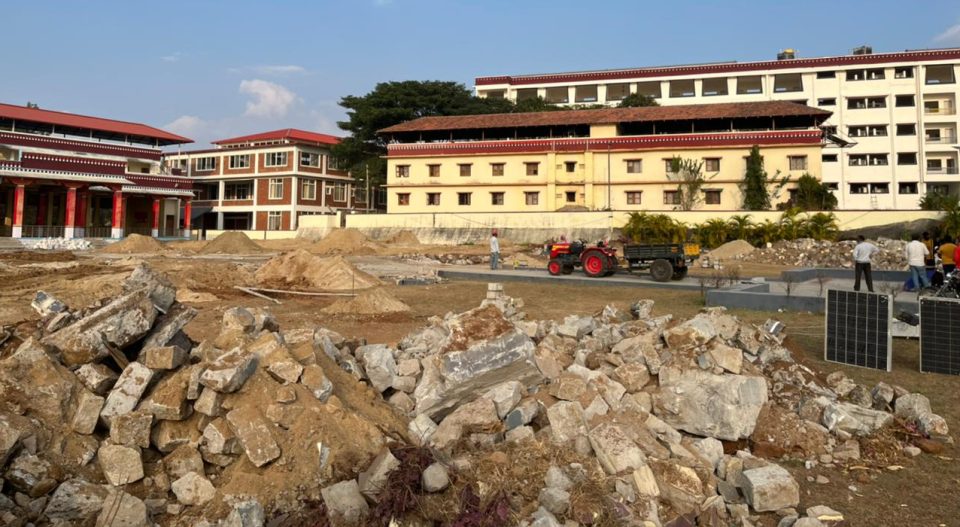
Site of the new debate courtyard being built at Tashi Lhunpo Monastery.
Debate is a very special way to develop wisdom and explore different subjects and helps the monks understand the teachings in a deep and clear way. This way, Dharma education becomes very real and sharp, not shallow or just words. As Lama Zopa Rinpoche has explained, “It is like an inner science of the two truths: absolute truth and conventional truth.”
Please join us in rejoicing in the offering of this grant which will benefit this monastery and help spread and preserve Mahayana Buddhism far into the future.
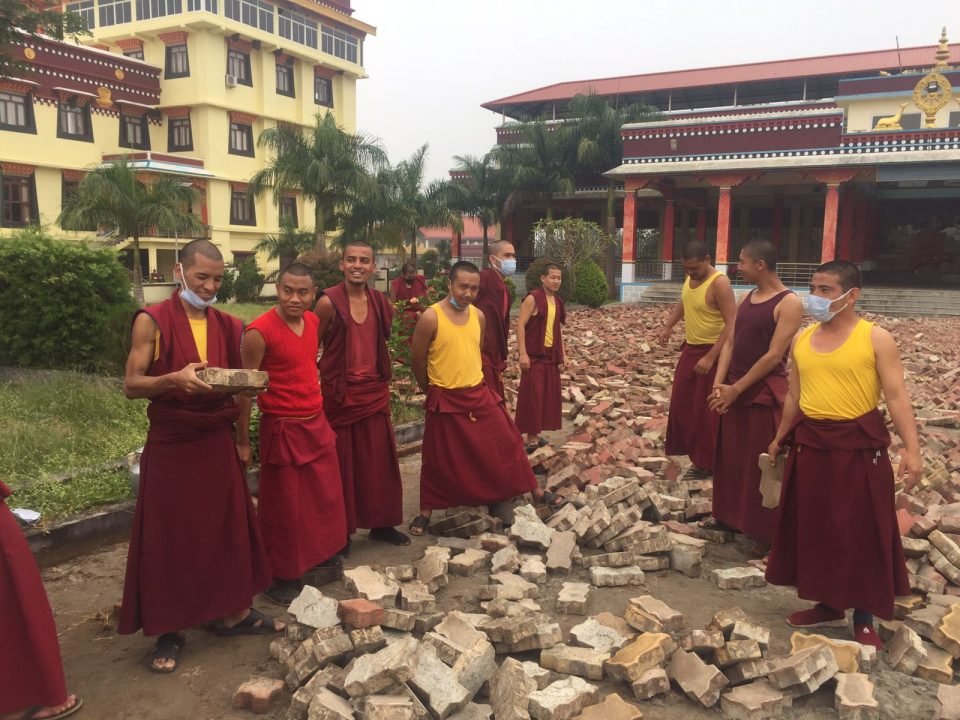
Monks of Tashi Lhunpo Monastery on the site of the new debate courtyard.
To support Sangha and learn how the Supporting Ordained Sangha Fund is directly benefiting monasteries and nunneries around the world, you can read all the latest news of this project: fpmt.org/projects/fpmt/supporting-ordained-sangha-fund/supporting-ordained-sangha-fund-news/
12
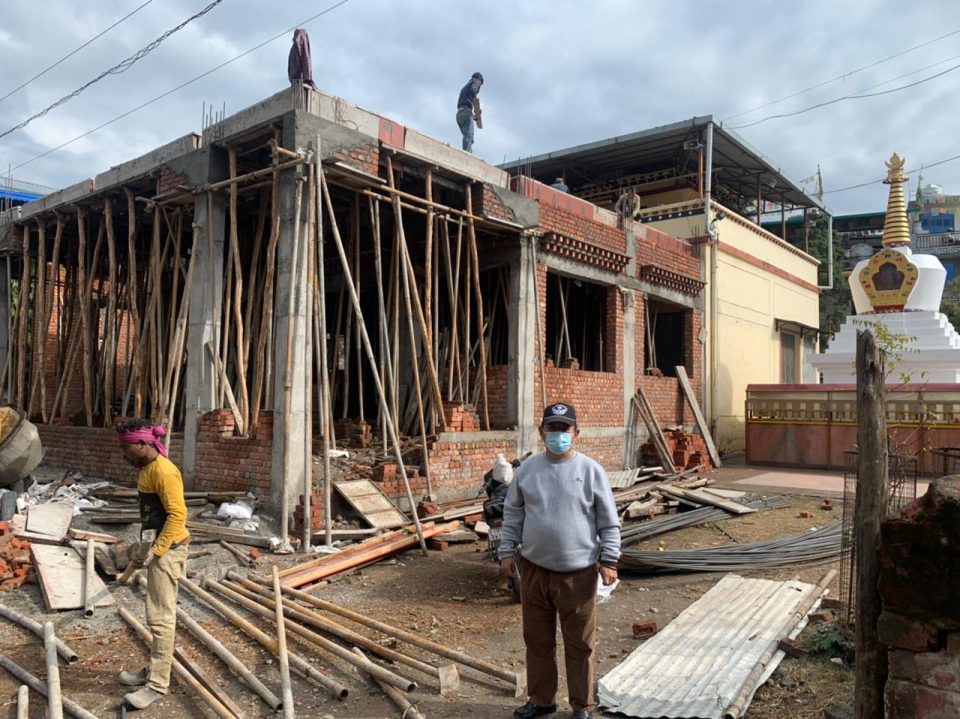
Continued progress on the new temple for Dekyiling Tibetan Settlement, Dehru, India.
A priority for FPMT Charitable Projects is to offer support to Tibetan settlements in various ways. Over 94,000 Tibetan refugees currently reside in India, where our support is focused. Dekyiling Tibetan Settlement is located near Dehru Dun, India. The Social Services Fund recently offered a grant to this settlement for funds needed to renovate their temple which is used for various Dharma activities, pujas, public teachings, initiations, and for welcoming high lamas and geshes. Their current temple would become too congested during gatherings and they lacked space for holy objects. Thanks to a kind and generous benefactor, US$35,105 was raised for this project.
According to Lama Zopa Rinpoche, Buddha explained in the Mindfulness Sutra the benefits of setting up rooms for monks, shelters, monasteries, and temples where there are holy objects of Buddha, Dharma, and Sangha– and holy objects of statues, stupas, and scriptures. This is called the abiding place. Abiding there is Buddha, Dharma, and Sangha. So the abiding place is a great, great place to subdue the mind, collect extensive merit, and to achieve enlightenment.

Some of the holy objects that need a proper temple for veneration at Dekyiling Tibetan Settlement.
Recently, the first foundation for the new temple was dug and laid, columns positioned and cast, brickwork and formation of window and door openings were completed. The metalwork support for the concrete roof is complete and they will soon be ready to pour the concrete. This will have to be left for twenty-one days to dry and then they can remove the supports and start the plastering inside and outside. Once that is dry, the painting can begin.
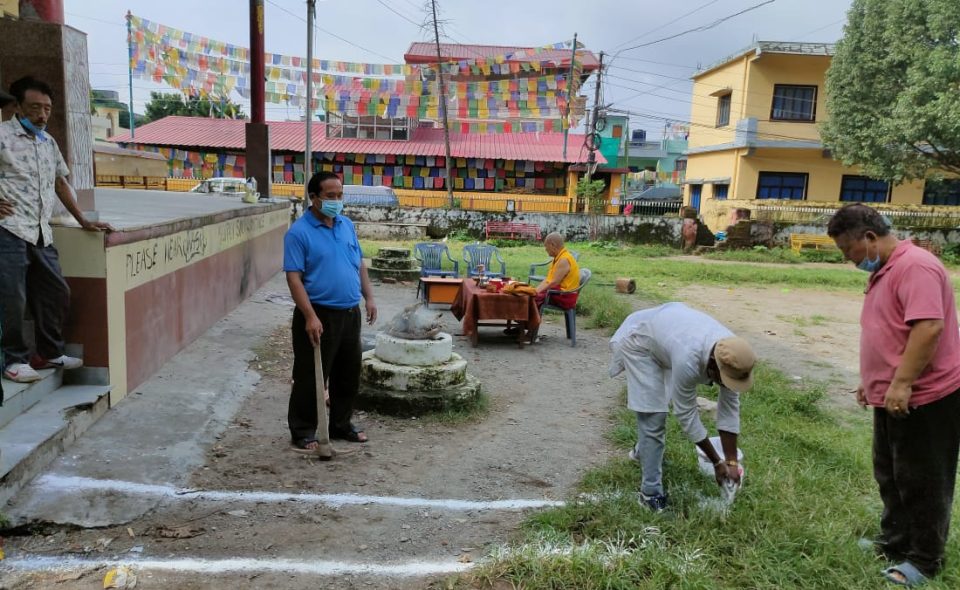
Beginning stages of renovation on the new temple at Dekyiling Tibetan Settlement .
Please join us in rejoicing that the support offered will assist this settlement maintain a vibrant and active community Dharma program at their temple, and contribute to the preservation of Tibetan culture within the population in India.
All are welcome to support the Social Services Fund and help ensure we can continue to offer direct support to Tibetan settlements.
23
Rejoicing in the Progress of Forty-two Foot Stupa in Hunsur, India
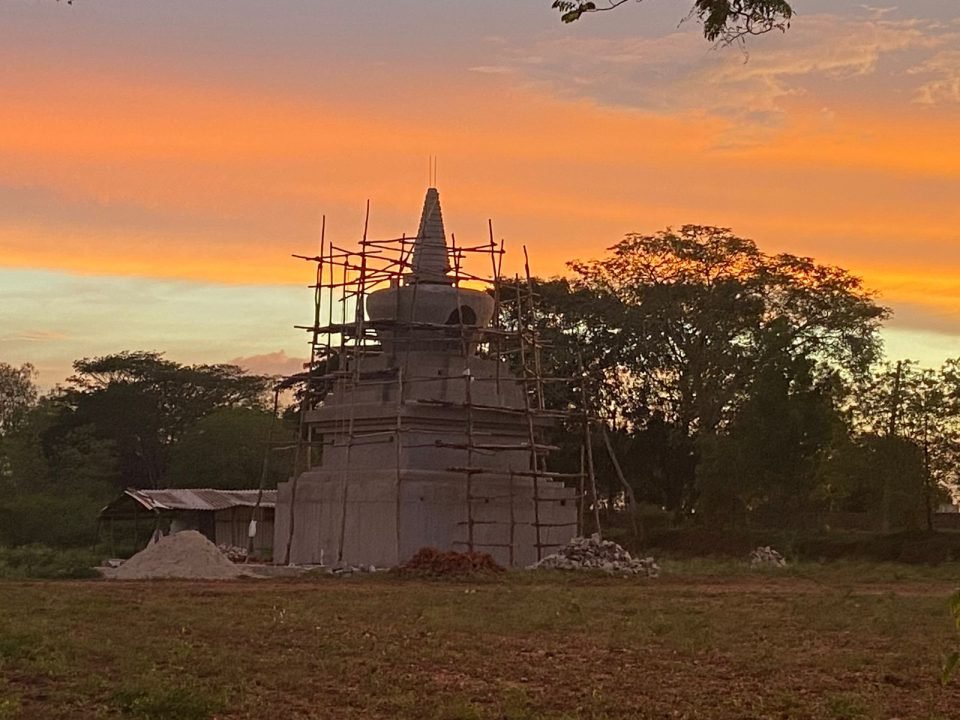
Beautiful thirty-five foot stupa being built in Hunsur, India.

Mantras and blessed holy objects which will fill the finished stupa.
Earlier this year we shared the news that a magnificent new forty-two foot stupa was sponsored and being built at Rabagayling Tibetan Settlement in Hunsur, India. We have been supporting an elderly home at this settlement caring for twenty residents since 2015.
We are so pleased to update you that tremendous progress on the stupa is being made. Mantras, relics, and holy images have been acquired to fill this beautiful stupa which will bless the entire settlement, anyone who visits the stupa, and all those who support it.
With holy objects such as statues, stupas and scriptures you do not have to have a mind unstained by anger, ignorance or attachment to create merit. For human beings or even animals, simply seeing the holy object becomes the cause to achieve inconceivable awakening and enlightenment by purifying so many defilements. The special advantage is that just by their existence these holy objects make it easy for us ordinary living beings to create merit. — Lama Zopa Rinpoche
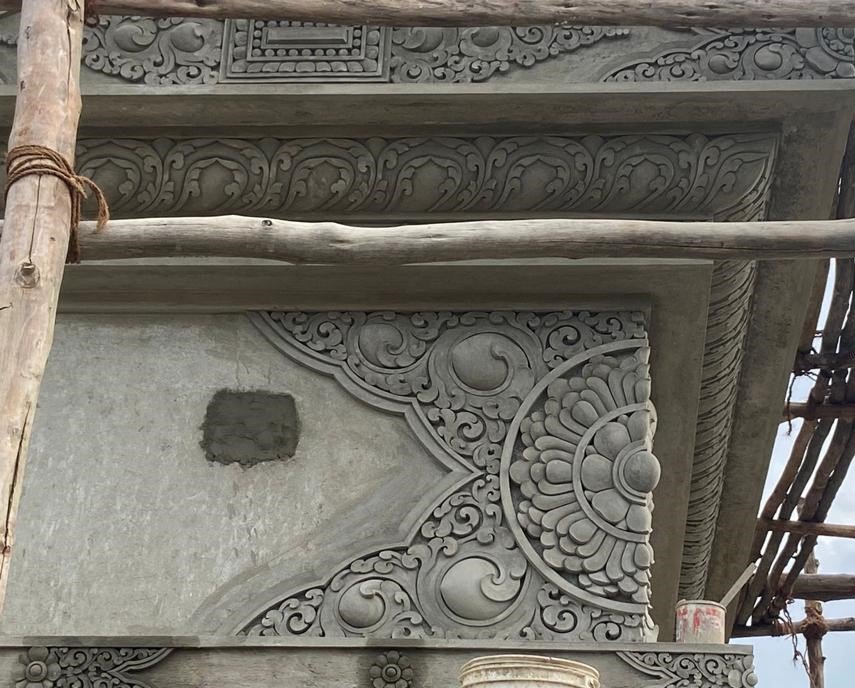
Intricate design detail on the beautiful stupa in Hunsur, India.
Please join us in rejoicing that another holy object is being built in the world which will be such a source of purification and merit for so many and help fulfill Lama Zopa Rinpoche’s vast vision for the FPMT organization and world.
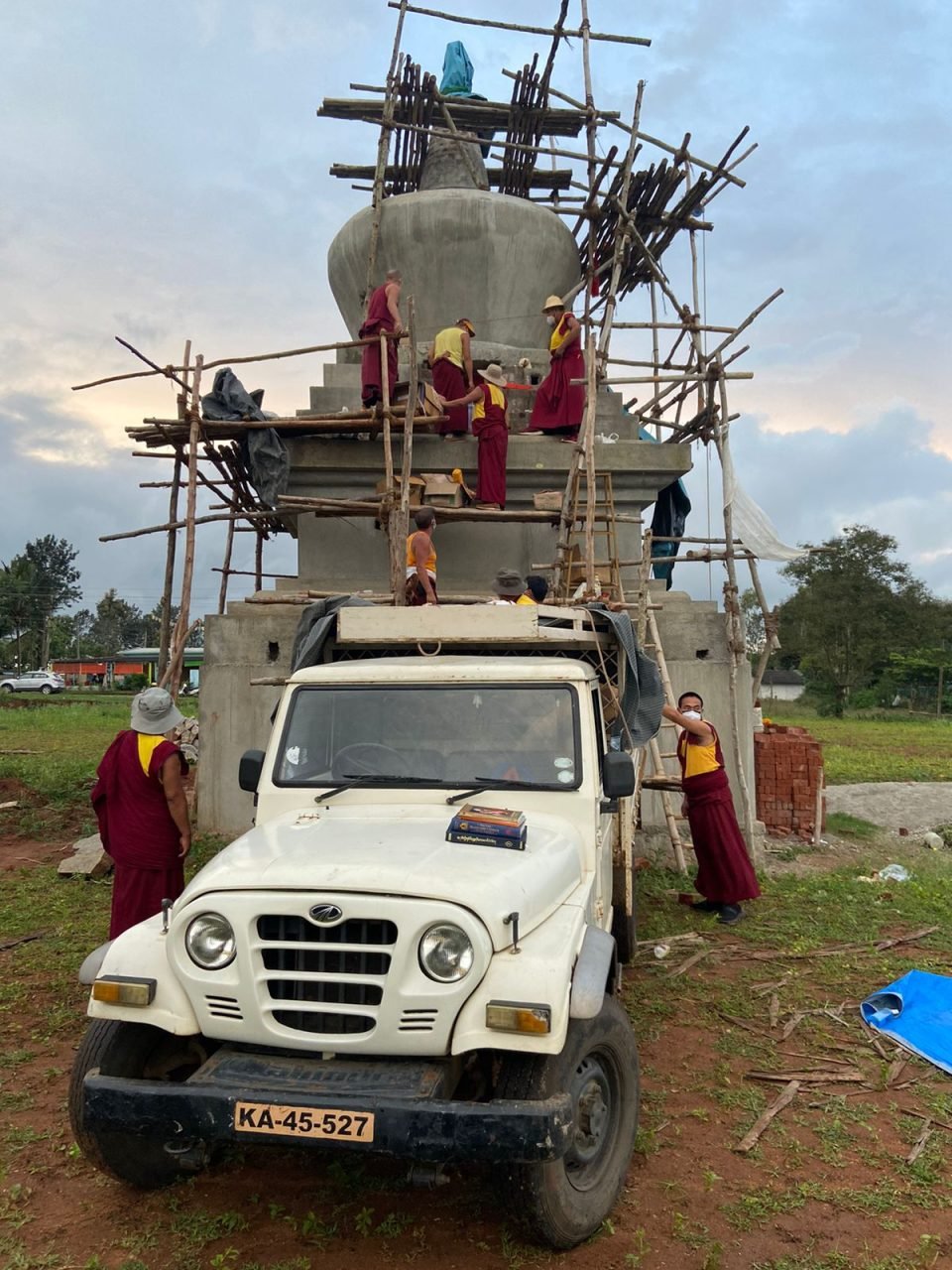
Work on the new large stupa in Hunsur, India.
If you would like to contribute to the building of stupas around the world, you are welcome to offer any amount to the Stupa Fund and help ensure that holy object grants like this continue.
- Tagged: elderly home, hunsur, stupa, stupa fund, stupas
9
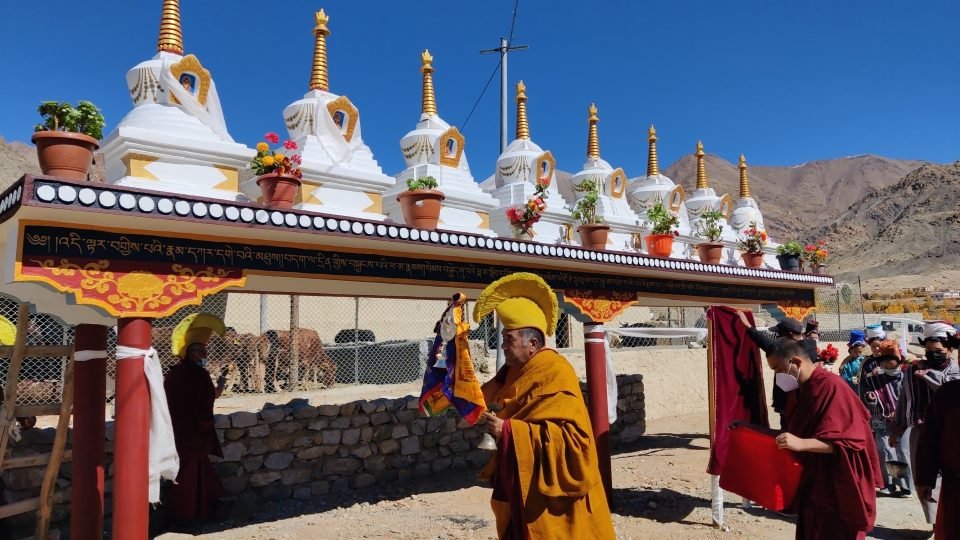
Inauguration of the eight new stupas to benefit the animals at Taru Gayphel Tsogspa Animal Welfare Society, Ladakh, October 20, 2021.
Earlier this year we shared news that we offered support to Taru Gayphel Tsogspa Animal Welfare Society, an animal sanctuary that is caring for fifty bulls, twenty cows, ten sheep, and five donkeys in Leh, Ladakh. In addition to a grant offered from the Animal Liberation Fund to help fund and expand their operation, Lama Zopa Rinpoche also advised and sponsored eight stupas, to be built on the land so that animals can circumambulate them to create merit, purify negativities, and plant positive seeds for the future. This is one unique way Rinpoche recommends to benefit animals, not only emphasizing the need for material care like shelter, medical care, and food which are so important for wellbeing in this life, but also the ultimate benefit to the animals in future lives, through taking them around holy objects, playing mantras, and so forth.

Some of the animals of Taru Gayphel Tsogspa Animal Welfare Society.
Please join us in rejoicing that these eight stupas are now completed and were recently inaugurated. Sangha from Ngari Institute, Taru villagers, and several esteemed guests joined for this joyous event as well. The beautiful stupas are placed easily for all the animals to circumambulate whenever possible.
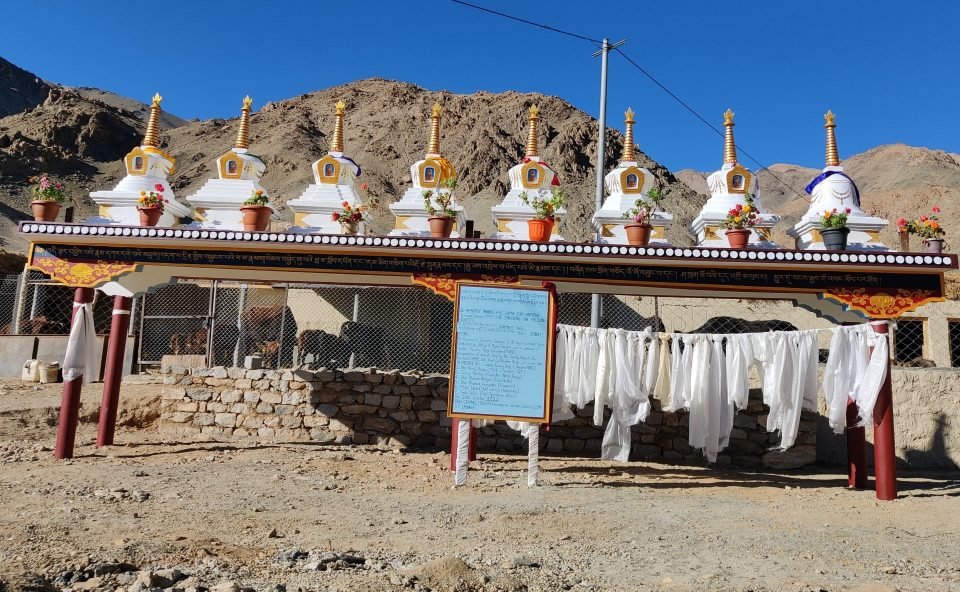
Beautiful new stupas which will benefit the animals of Taru Gayphel Tsogspa.
About circumambulating stupas, Lama Zopa Rinpoche has said, “One receives skies of benefit, inconceivable merit. There is no deflation and inflation. It’s not like the value of gold or the dollar and so forth, which goes up and down; it’s not like the value of material things, which goes up and down. The resultant happiness is inconceivable due to the power of the object, of the Buddha, it’s always the same. Due to things being empty of existing from their own side, dependent arising, it’s always the same. The Buddha’s power never decreases, the Buddha’s compassion toward sentient beings never decreases, the Buddha’s qualities never decrease, they are always the same, having infinite qualities and never decreasing. Therefore, all these practices that we do—circumambulation, prostrations, offering—even to a statue or a painting of Buddha, the benefit is always infinite.
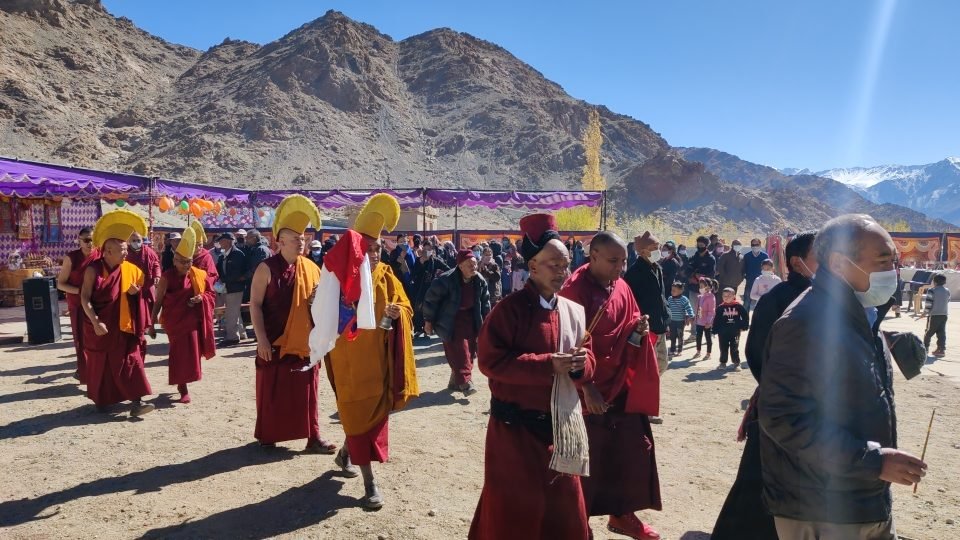
Many joined in the joyous occasion of the stupa inauguration.
Taru Gayphel Tsogspa offered the following words of thanks, “We would like to heartfelt thanks His Eminence Lama Zopa Rinpoche, Ven. Roger Kunsang, and all the devotees and sponsors, without their support this would not be completed. May this merit cause all sentient beings to be free from suffering and complete enlightenment. Long live His Holiness the Dalai Lama and His Eminence Lama Zopa Rinpoche.”
You can read more about our support offered to Taru Gayphel Tsogspa Animal Welfare Society.
All are welcome to support the Animal Liberation Fund and Stupa Fund and help ensure beneficial grants like this can continue.
1

One of the 1,000 statues completed for His Holiness the Dalai Lama’s long life.
In 2019 we shared Lama Zopa Rinpoche’s wish to offer 1,000 statues of Shakyamuni Buddha to His Holiness the Dalai Lama for his long life on behalf of the entire FPMT organization. The funds for this ambitious project were raised quickly and the statues were created, filled, painted, gold-gilded, all 2,000 eyes carefully opened, and then consecrated. This process took over a year with artists staying at Tushita Meditation Centre to complete. The statues were filled with the appropriate mantras and in January 2020 Rinpoche met with His Holiness in Bodhgaya and formally offered the 1,000 statues. His Holiness immediately started prayers and offered the consecration of all the statues.
Due to pandemic restrictions, there was some delay in getting the physical statues to His Holiness, so they were all carefully boxed and kept dry and safe at Tushita Meditation Centre. In late October 2021, the actual offering was finally arranged, and we are so delighted to report that now all 1,000 Buddhas have been offered.
We would like to offer a heartfelt appreciation and thanks to Kopan Monastery and Khachoe Ghakyil Ling Nunnery, especially to Gen Tenpa Choden for working so hard to actualize this amazing offering and also to the director of Tushita, Pema Wangmo, the monks and nuns of Kopan and Gyudmed monasteries, and the artists who worked extremely hard. We also gratefully acknowledge all the donors who made this incredible offering possible.
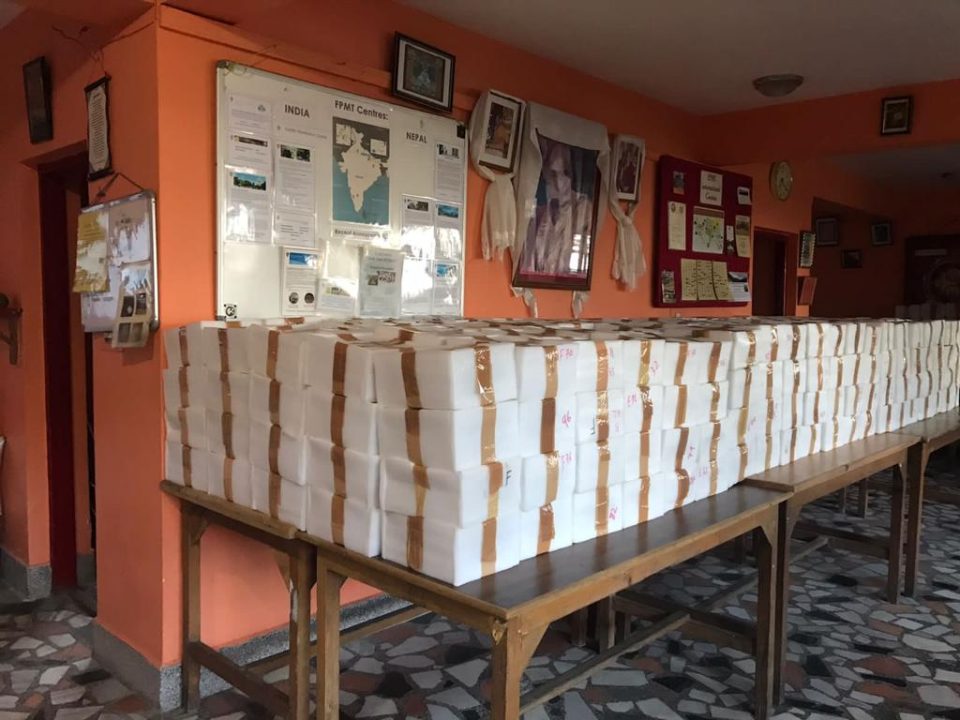
All of the 1,000 statues of buddha, packaged carefully for transport.
Please join us in rejoicing in the creation of 1,000 beautiful statues of Buddha for the long life of His Holiness the Dalai Lama on behalf of all within the FPMT organization.
To help ensure grants like this continue toward holy objects, all are welcome to offer a donation of any amount to the Holy Objects Fund.
23
New Ksitigarbha Statue in Nepal Village for Protection and Blessings
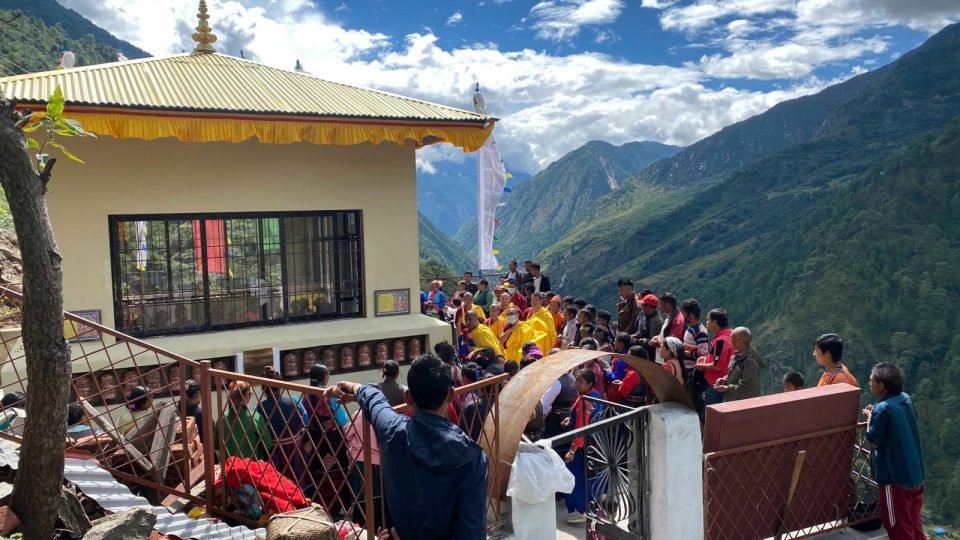
Consecration of new Ksitigarbha statue in Nepal.
Recently Lama Zopa Rinpoche sponsored a beautiful standing Ksitigarbha statue for a remote village in Nepal as protection from disaster and the elements, and for the benefit all of beings. Moved by Rinpoche’s generosity in sponsoring this magnificent holy object for the village, the villagers came together to build a beautiful temple in which to house the statue. The temple has prayer wheels around the outside for anyone to turn and special mandalas and protections on the inside and outside to bless people upon seeing. The statue was filled and blessed at Kopan Monastery before being sent to its final home in the new temple. Monks from Kopan traveled to the village to consecrate the statue and bless the temple.
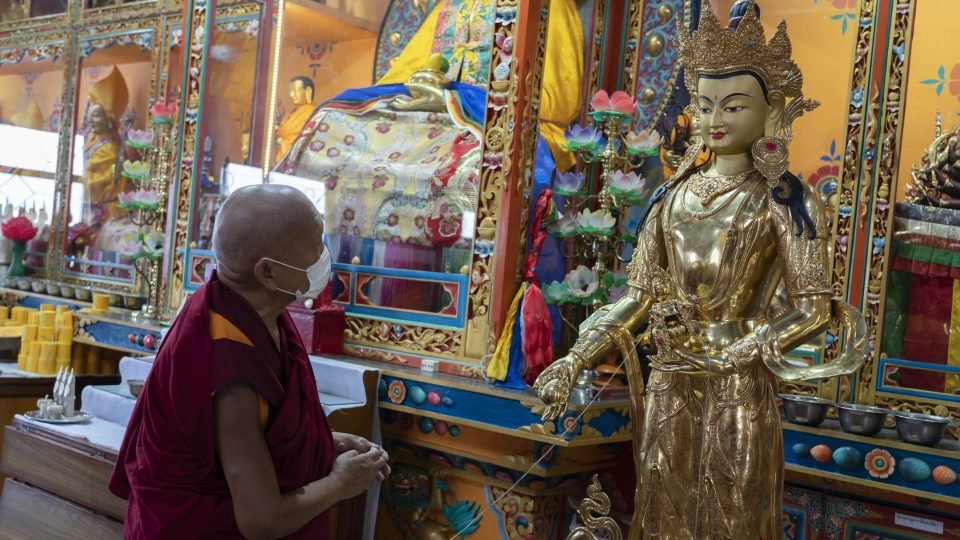
Lama Zopa Rinpoche blessing the new Ksitigarbha statue at Kopan Monastery before it was sent to the village.
The bodhisattva Ksitigarbha is relied on to avert danger and purifies obstacles. Lama Zopa Rinpoche has recommended Ksitigarbha mantras and practice to mitigate disasters of the elements such as earthquakes and tsunamis. You can listen to audio of Rinpoche reciting the long mantra of Ksitigarbha.
“Every single holy object is the basis for you to create all the merits that bring every success and pleasure that you experience now, as well causing your future liberation and enlightenment. Whether a person is Buddhist or not, just seeing a holy object allows them to create soooo much merit.” —Lama Zopa Rinpoche
Please enjoy this short video of the consecration:
In this short video you can see the vast and beautiful landscape of the site for the new statue:
Please join us in rejoicing in the creation of this incredible holy object in Nepal!
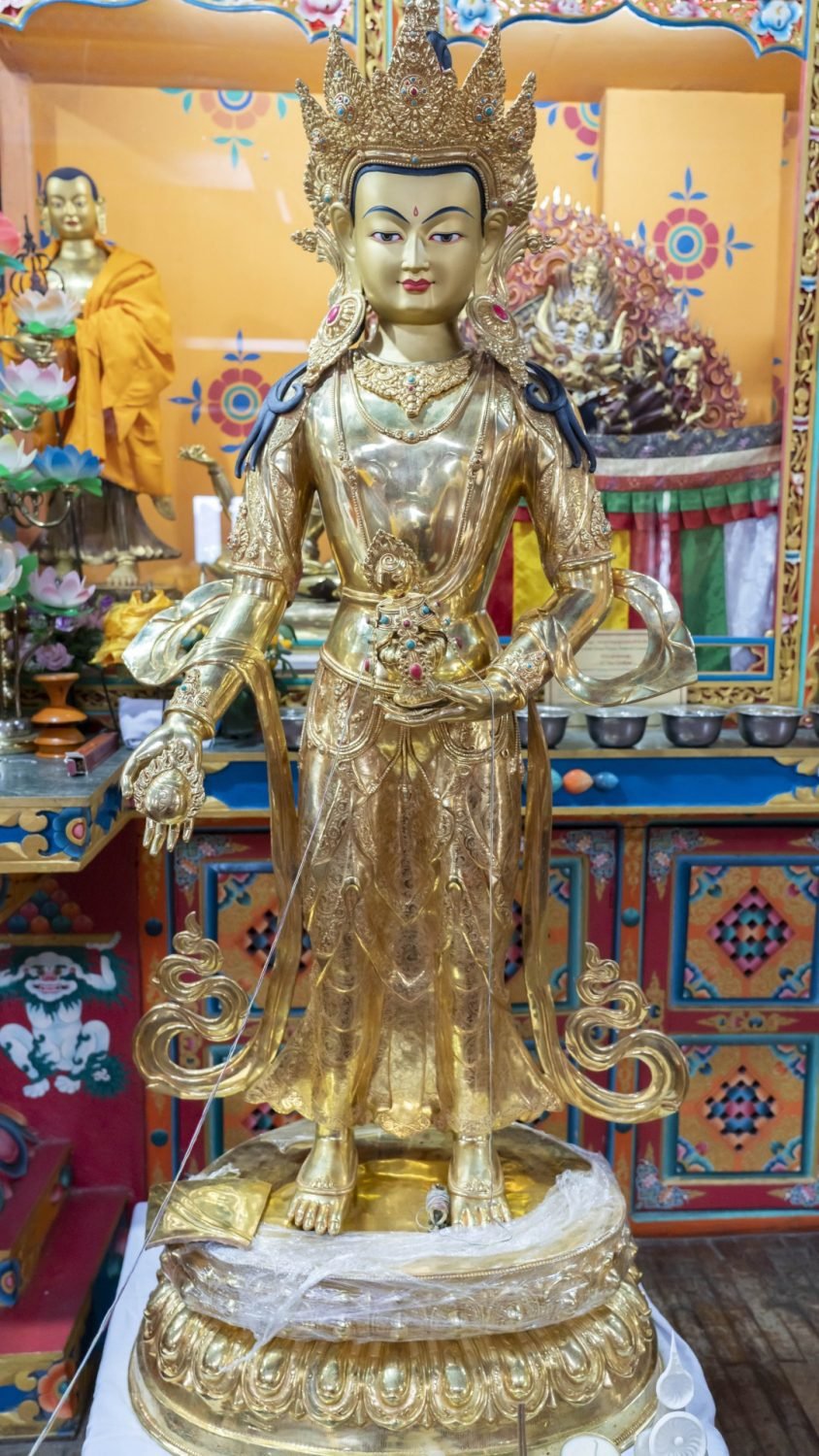
Beautiful new Kstibarbha statue.
You can read more about other powerful holy objects that we have sponsored recently.
If you would like to contribute to the building of holy objects around the world, you are welcome to offer any amount to the Holy Objects Fund which contributes to the creation of stupas, prayer wheels, and statues.
9
Two New Ambulances for the Benefit of Tibetan Settlements
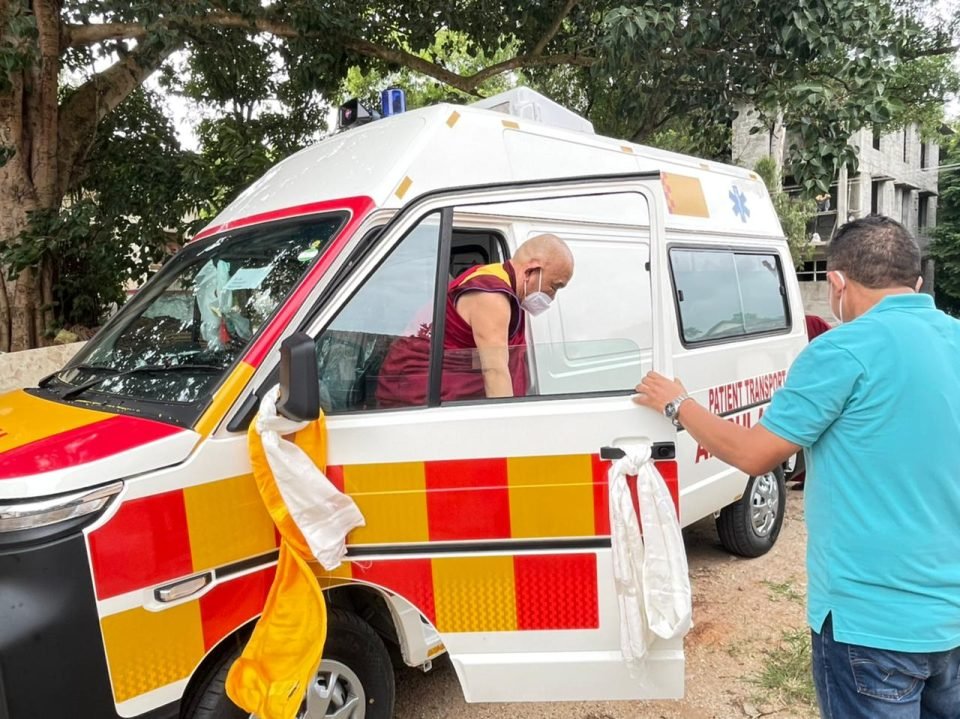
A monk blessing the new ambulance for Rabgayling Tibetan Settlement.
We were very happy to share news of sponsorship for two ambulances in two different Tibetan settlements in India, through the Social Services Fund.
Rabgayling Tibetan Settlement in Hunsur, India is situated on 2,000 acres and was established in 1971 for the development of villages, hospitals, schools and monasteries. The population of this settlement is currently at 1,900. This settlement has an elderly home that serves twenty residents which we have been supporting since 2016. We were delighted to sponsor a new ambulance which will be used to transport those in need of care to Phende Hospital located on the settlement.
An ambulance was also sponsored for transportation to Tsojhe Khangsar Hospital for individuals from two Tibetan settlements in Bylakuppe, India, encompassing 20,000 people including monks and nuns residing in surrounding monasteries and nunneries. The ambulance was consecrated by some monks of Sera Je Monastery. We have been supporting an elderly home in one of these settlements, Lugsam Samduling, which serves nearly fifty elderly residents, since 2016.
Lama Zopa Rinpoche offered advice to have special stickers and mantras—such as Namgyalma Mantra and Lotus Pinnacle of Amoghapasha Mantra—put on the ambulances to bless all the people who use them and see them, thus making these vehicles not only the means for others to receive medical support they desperately need, but to create merit and make a Dharma connection every time they enter or see the ambulances.
Please join us in rejoicing in the utilization of these two ambulances within Tibetan settlements in India.
All are welcome to support the Social Services Fund and help ensure we can offer direct support to those in need.
- Tagged: elderly homes, lugsam samduling settlement, rabgayling tibetan settlement, social services fund
26
Incredible Opportunity to Offer to 10,000 Sangha on Lhabab Duchen
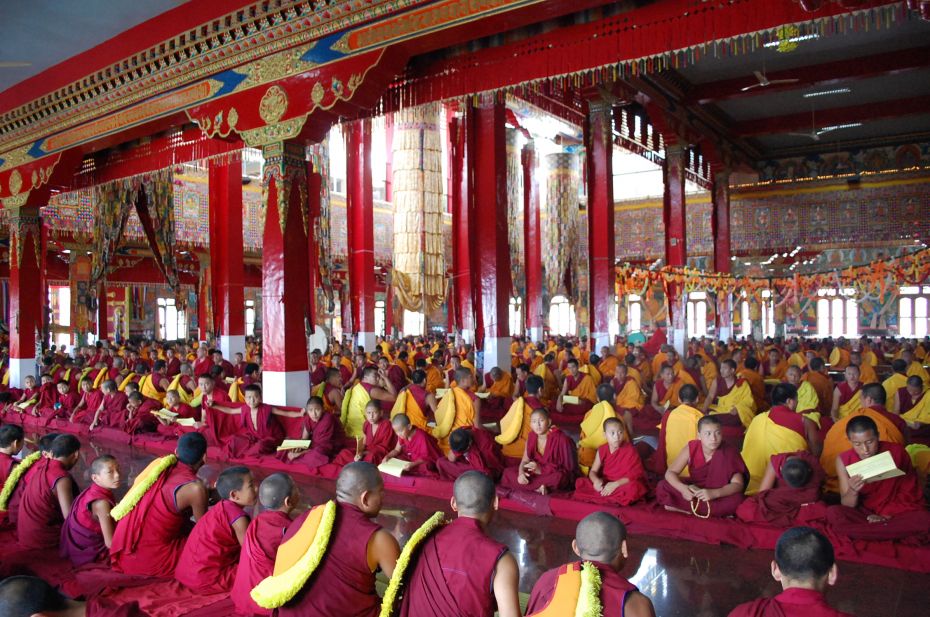
Monks of Sera Mey Monastery offering a puja sponsored by the FPMT Puja Fund, prior to local restrictions.
The Puja Fund was established in 1995 as an expansive way for the organization to clear obstacles and generate the merit needed to be of most benefit in the world.
Incredible Opportunity This Lhabab Duchen
On the auspicious day of Lhabab Duchen (October 27), when the merit is magnified one hundred million times, the Puja Fund will be making and extensive monetary offering to 10,000 ordained sangha in India and Nepal. The sangha will be engaged in the recitations of the Prajnaparamita, Golden Light, Arya Sanghata, Vajra Cutter, and Amitayus Long Life sutras and will dedicate the merit of reciting these incredible sutras to all beings and in particular for the FPMT family, for all of the Dharma activities to succeed, and for all the kind donors of the Puja Fund.
In addition there will be robes offered to the Shakyamuni Buddha statue in the Mahabodhi Temple in Bodhgaya, and saffron and umbrellas offered to the Boudhanath and Swayambunath stupas. These offerings happen monthly throughout the year and always on merit-multiplying days.
If you would like to join in this vast offering, please offer any amount to the
Puja Fund
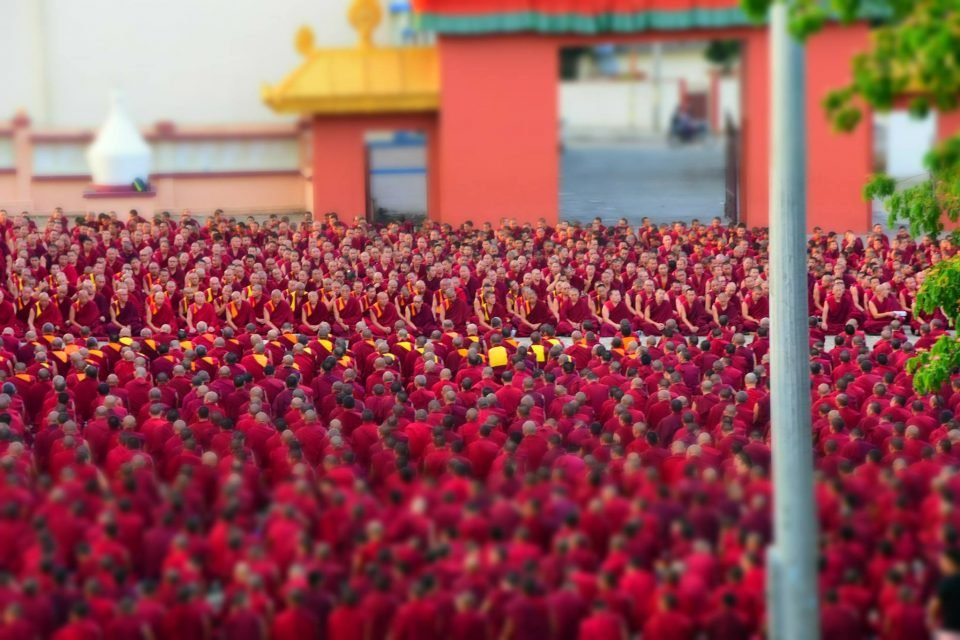
The monks of Sera Je Monastery.
An Increase of Offerings Due to Pandemic Difficulties
Current pandemic regulations prohibiting large gatherings have impacted monks and nuns in monasteries and nunneries all over India and Nepal who rely on support from offering the service of pujas and other prayers for individuals who request this from around the world. Due to this, Lama Zopa Rinpoche has increased the offerings we make to each sangha member eight-fold this year. We are honored to directly support sangha in this way. With this increase the amount being offered this Lhabab Duchen is US$40,000.
The Buddha described the vast benefits that arise from making offerings to ordained sangha, the Sangha Jewel, who are living in pure morality. Lama Zopa Rinpoche has explained that the sangha are the “real heroes” among us because they are working to defeat the delusions and thus living the best lives as human beings. Also, offering to those who are disciples of the same guru, His Holiness the Dalai Lama, becomes offering to the most powerful object of devotion, one’s own guru.
Making Merit Wisely
Lama Zopa Rinpoche has encouraged students to create merit wisely in order to generate the greatest success and fulfill our wishes. The upcoming Buddha multiplying day offers us one of those wise opportunities because merit is multiplied by 100 million times. And if one generates a bodhichitta motivation—the thought to achieve enlightenment for all sentient beings—while making an offering, this becomes the cause to achieve enlightenment for all sentient beings and is the most powerful way to purify all the defilements you have accumulated since beginningless rebirths. This is very smart business and the best way to create the most extensive merit for yourself and others.
If you would like to make an offering to the Puja Fund for this purpose, please remember on the actual day (October 27) to rejoice in the offering you have made, to rejoice in the activities of the sangha who are engaged in the recitations, and to dedicate all the merit generated.
You can learn more about the beneficial prayers, practices, and pujas sponsored by the Puja Fund, or about FPMT’s other extensive charitable activity.
- Tagged: buddha day, puja fund, pujas
20
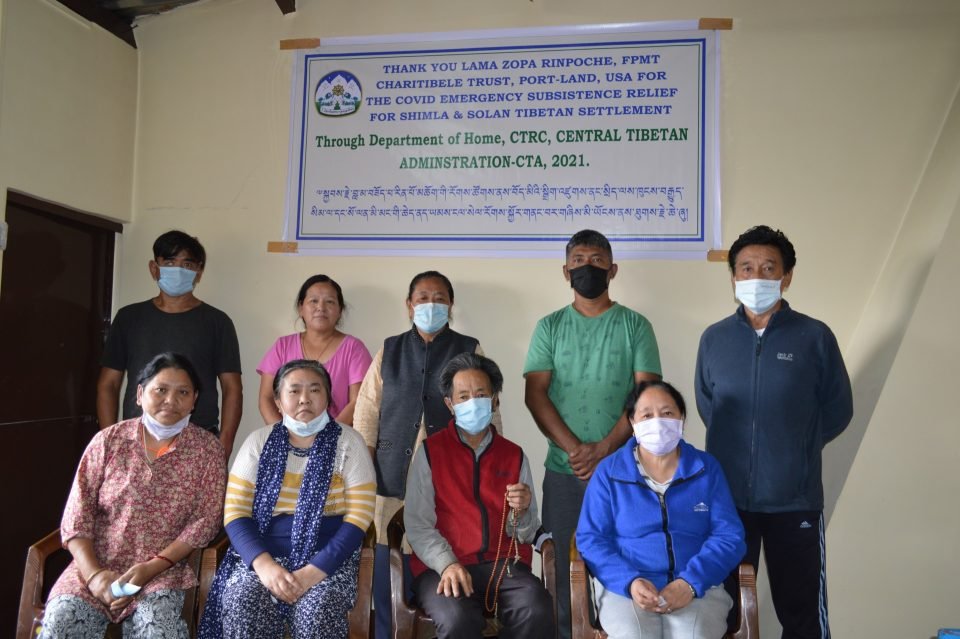
Recipients of the pandemic aid offered through a grant from FPMT Charitable Projects.
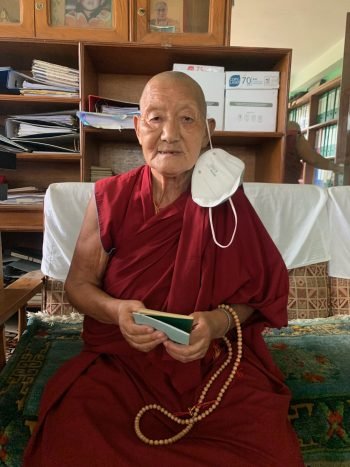
Pandemic aid recipient expresses thanks to FPMT Charitable Projects.
Recently His Holiness the Dalai Lama’s Central Tibetan Relief Committee, the Department of the Home, arranged special support in the form of direct cash assistance as a relief measure to alleviate the financial burden of vulnerable Tibetans affected by the pandemic. The aim of this offering was to prevent Tibetan households and destitute people in India, Nepal, and Bhutan from falling into poverty due to their inability to earn income during the pandemic.
When Lama Zopa Rinpoche heard of these efforts he immediately wanted to offer support to this initiative with a grant in the amount of US$50,000.
Due to this grant, a total of thirty-eight settlements in India, Nepal, and Bhutan were helped: 196 vulnerable households were given Rs. 10,000 and 340 destitute elders were given Rs. 5,000.
Rinpoche also recently offered a US$20,000 grant to Kopan Helping Hands for their work distributing food to 400 families affected by the pandemic who have lost their livelihoods and also for working with trusted local contacts to identify elderly people living by themselves and families without any means of support in the Upper Solu Khumbu area of Nepal. Food will likely be distributed to them through the local shops.
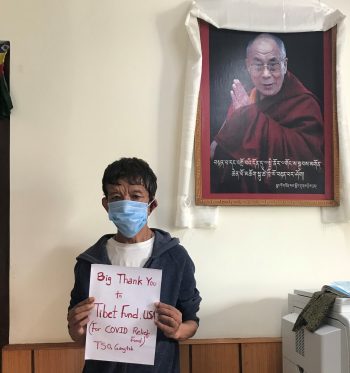
Pandemic aid recipient expresses thanks to FPMT Charitable Projects.
The financial impact of the pandemic has been especially devastating for the poorest households in Tibetan settlements. According to a rapid survey conducted in June, 2,774 households across India, Nepal, and Bhutan are now struggling to afford basic necessities and are at risk of falling into a cycle of poverty from which they cannot soon reemerge.
Thanks to so many generous donors we are able to offer grants like this that have direct impact on the lives of those who truly need support and kindness.
All are welcome to be part of the aid we are able to provide through our Social Services Fund by donating any amount or rejoicing in work we do.
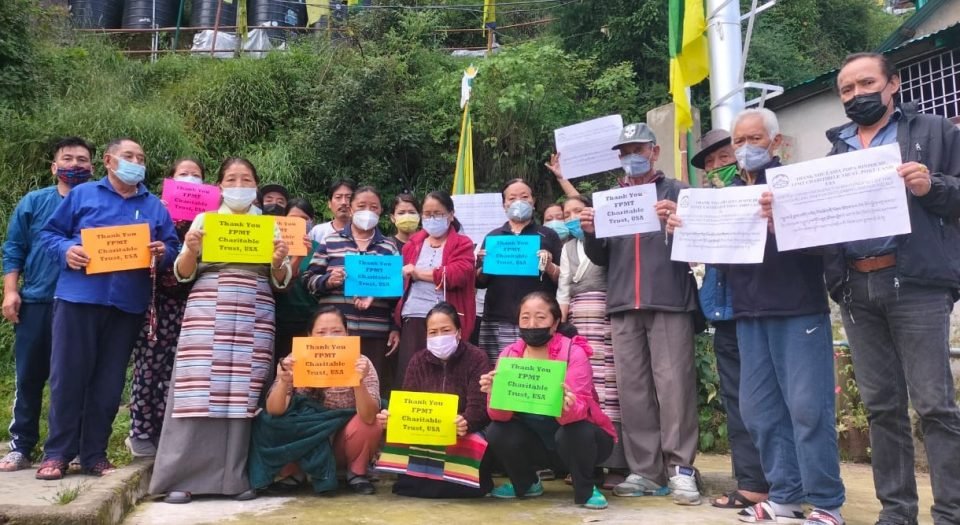
Words of appreciation from those who benefited from a recent distribution of aid from Central Tibetan Relief Committee.
Please learn more about the Social Services Fund and all of the ways we offer support toward those in need.
8
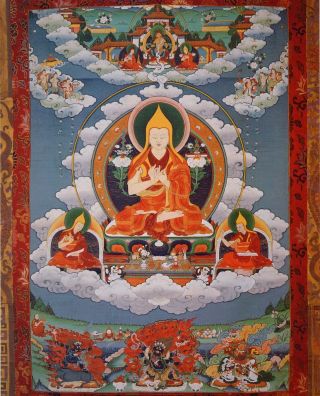
Lama Tsongkhapa (1357-1419).
Lama Tsongkhapa (1357-1419) was a Tibetan Buddhist master whose studies and meditations in all the major schools of Tibetan Buddhism resulted in the founding of the Gelugpa lineage. The Lama Tsongkhapa Teachers Fund was established by FPMT in 1997 at the request of His Holiness the Dalai Lama. The purpose of the fund is to invest in the preservation of the Gelugpa School of Tibetan Buddhism by supporting the teachers of tomorrow. Preserving the Mahayana tradition is the primary objective of the entire FPMT organization and the Lama Tsongkhapa Teachers Fund is one substantial way to help continue this work.
Exams
Every year this fund offers a grant for for daily food and travel expenses of the annual Gelug Exam. This year 1157 monks from eight monasteries are participating. The geshes and monks taking these exams are some of the top scholars coming from the main monasteries and will become future teachers, benefiting so many. This year, due to pandemic restrictions, the monks from Sera and Tashi Lhunpo monasteries participated at Sera Monastery in Bylakuppe, and the monasteries from the settlement in Mundgod participated at their respective monasteries. The cost of supporting the exams in 2021 was US$7,200.
Also a grant for US$4,945 was offered to Sera Je Monastery for 260 monks who passed an annual Special Memorization Exam. Each of these monks received a new set of robes and a cash offering for memorizing as follows:
- 78 monks memorized Commentary of Clear Meaning
- 113 monks memorized Explanation of the Provisional and True Meaning
- 50 monks memorized Bodhisattvacaryavatara (Guide to the Bodhisattva’s Way of Life)
- 13 monks memorized the first chapter of General Meaning of Paramita
- 2 monks memorized General Meaning (of the) Middle Way
- 1 monks memorized Six Logical Scriptures of the Madyamika
- 2 monk memorized Five Treatises of Maitreya
- 1 monk memorized the Root Text of Pramanavartika
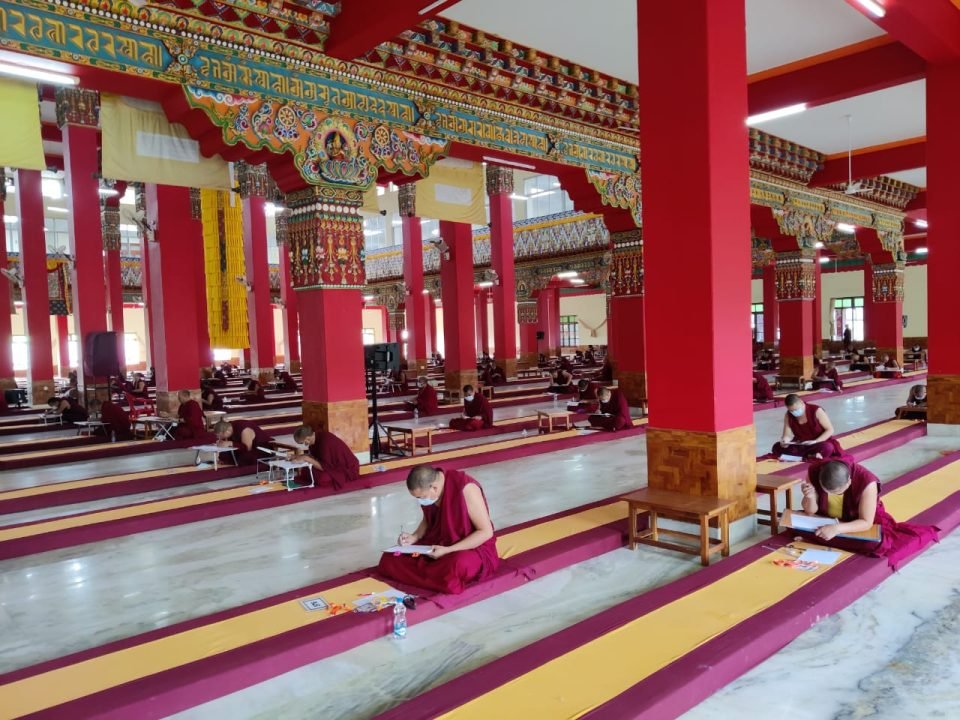
Monks studying for exam.
Investing in Teachers
A monthly offering from this fund is to provide stipends for 139 of the main teachers of the Lama Tsongkhapa tradition, including current and past abbots. This small offering of money supports these teachers’ basic needs and allows them to focus more of their time on transmitting Dharma to their students at the monasteries and strengthening their own practices. In 2021, US$11,900 was offered for this.
On advice from His Holiness the Dalai Lama, the Geluk International Foundation established a program for thirty geshe lharampas from six major monasteries and five geshemas from various nunneries to specialize in one of the five major texts. A yearly grant was previously offered from another organization within the US to help pay for these individuals to complete this extensive study for ten years. The Lama Tsongkhapa Teachers Fund agreed to take over this fund to distribute a yearly grant of US$87,500 until their studies are complete.
Investing in Buddhist Communities
The Nepal Buddhist Gelug Association was established ten years ago by the monasteries and nunneries of Nepal to preserve and develop the Tibetan Buddhist tradition in general, and the Lama Tsongkhapa lineage in particular, by elevating the standard of Buddhist studies within the monastic institutions of Nepal and the local communities. Recently a grant for US$150,000 was offered so that the following objectives could be accomplished:
- Continuation of the annual Jang Guncho Winter Debate Session
- Continuation of the Great Gelug Annual Examinations
- Conducting programs to educate local people in the Himalayan regions of Nepal on Buddhism
- Building a library to boost Buddhist education
- Supporting the construction of stupas and prayer wheels in remote villages
- Organizing offerings during the Gaden Ngacho Chenmo celebration of Tsongkhapa’s life and seminars on the Prajnaparamita Sutra
- Organizing workshops and projects to encourage dialogue between Buddhism and science
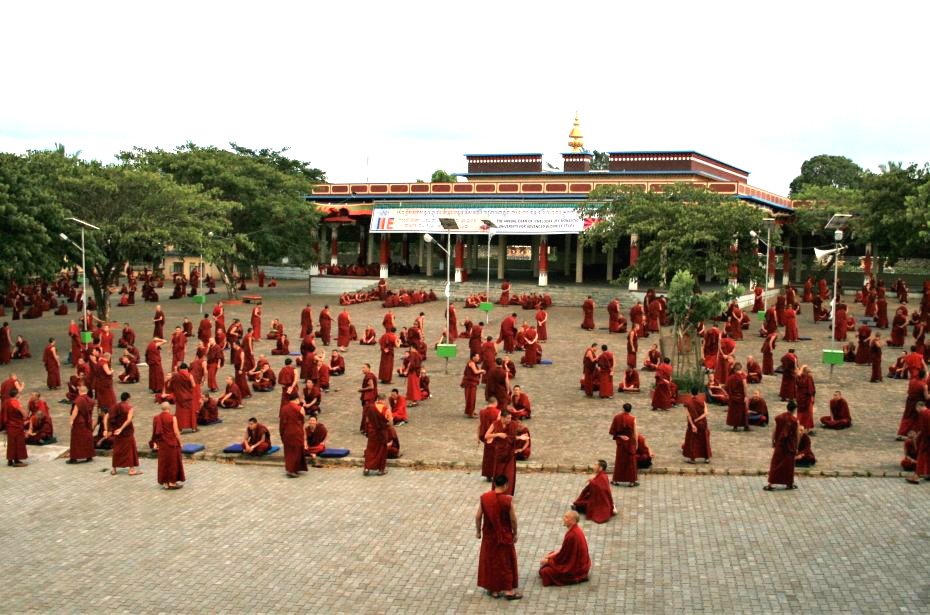
Debate in the courtyard at Sera Je Monastic University, 2009, India. Photo courtesy of Ryan Matsumoto.
An Unbroken Lineage
Please join us in rejoicing in the recent grants offered to these various activities, which help sustain Lama Tsongkhapa’s unbroken lineage in the Gelug monastic institutions, and thus, around the world as these scholars become teachers and spread the precious teachings.
“Taking responsibility for supporting these practitioners is extremely worthwhile because they are preserving and spreading the entire teaching of the Buddha.” – Lama Zopa Rinpoche
Since its inception, the Lama Tsongkhapa Teachers Fund, an extension of the Supporting Ordained Sangha Fund, has supported the preservation of the Gelug School of Tibetan Buddhism.
- Tagged: lama tsongkhapa teachers fund
- Home
- News/Media
- Study & Practice
- About FPMT Education Services
- Latest News
- Programs
- New to Buddhism?
- Buddhist Mind Science: Activating Your Potential
- Heart Advice for Death and Dying
- Discovering Buddhism
- Living in the Path
- Exploring Buddhism
- FPMT Basic Program
- FPMT Masters Program
- FPMT In-Depth Meditation Training
- Maitripa College
- Lotsawa Rinchen Zangpo Translator Program
- Universal Education for Compassion & Wisdom
- Online Learning Center
- Prayers & Practice Materials
- Overview of Prayers & Practices
- Full Catalogue of Prayers & Practice Materials
- Explore Popular Topics
- Benefiting Animals
- Chenrezig Resources
- Death & Dying Resources
- Lama Chopa (Guru Puja)
- Lama Zopa Rinpoche: Compendium of Precious Instructions
- Lama Zopa Rinpoche: Life Practice Advice
- Lama Zopa Rinpoche Practice Series
- Lamrim Resources
- Mantras
- Prayer Book Updates
- Purification Practices
- Sutras
- Thought Transformation (Lojong)
- Audio Materials
- Dharma Dates – Tibetan Calendar
- Translation Services
- Publishing Services
- Teachings and Advice
- Find Teachings and Advice
- Lama Zopa Rinpoche Advice Page
- Lama Zopa Rinpoche: Compendium of Precious Instructions
- Lama Zopa Rinpoche Video Teachings
- ༧སྐྱབས་རྗེ་བཟོད་པ་རིན་པོ་ཆེ་མཆོག་ནས་སྩལ་བའི་བཀའ་སློབ་བརྙན་འཕྲིན།
- Podcasts
- Lama Yeshe Wisdom Archive
- Buddhism FAQ
- Dharma for Young People
- Resources on Holy Objects
- Ways to Offer Support
- Centers
- Affiliates Area
- Teachers
- Projects
- Charitable Projects
- Make a Donation
- Applying for Grants
- News about Projects
- Other Projects within FPMT
- Support International Office
- Projects Photo Galleries
- Give Where Most Needed
- FPMT
- Shop
Translate*
*powered by Google TranslateTranslation of pages on fpmt.org is performed by Google Translate, a third party service which FPMT has no control over. The service provides automated computer translations that are only an approximation of the websites' original content. The translations should not be considered exact and only used as a rough guide.No anger inside means no enemy outside.







